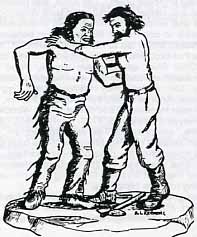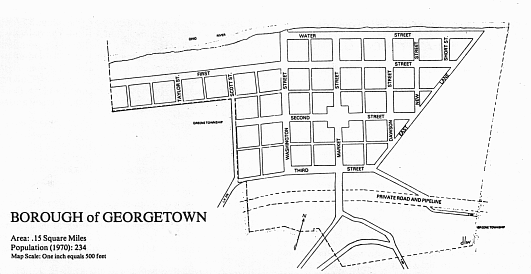
Bigfoot and Adam Poe
Click Here to Return To Milestones Vol 8 No 1
Georgetown lies in the extreme northwestern corner of Greene Township, Beaver County, Pennsylvania on a high plateau overlooking the Ohio River within sight of parts of Ohio, West Virginia and Pennsylvania. The name was originally spelled GEORGE TOWN. The origin of the name seems to be questionable. One theory is that it was named for George, the son of Benoni Dawson, who owned part of the original plot. Another idea is that it was named for the Georgetown which adjoins the nation's capital. However, a plaque which has been placed at the village credits George Washington with having founded the town since he once camped there overnight on his trip through the valley.
Georgetown owes its existence to Benoni Dawson, who purchased two hundred acres of land from Robert D. Dawson, who had received it from the government for his services during the Revolutionary War. The number of the patent was P-15-269 and it was located in Greene Township. Dawson named his patent "The Bone of Contention." The deed can be found in Book E Page 244 at Allegheny County Court House. Benoni Dawson had erected on his land a blockhouse about 1790 which would ensure the safety of the settlers from Indian attacks, but his son, Thomas, constructed another on the opposite side of the river; so it was no longer needed and finally was demolished.
There is some question as to whether Beaver or Georgetown was the first town established in Beaver County. Beaver was laid out by an Act of Assembly on September 28, 1791 by Daniel Leet, his survey being made in November 1792 although it was not confirmed until March 6, 1793; while Georgetown was laid out January 13, 1793 when Benoni Dawson finished his survey of the land. It would appear that Beaver was the first town erected in the country.
A traveller who stopped at Georgetown in 1807 noted "the considerable thoroughfare of traders" and described the town as "containing about thirty houses in a fine situation on a narrow plain, extending from the high river bank to the hills which surround it like an amphitheater." S.M. Prudens and Thomas Foster were early merchants.
The Dawson family were the most numerous of any family in this settlement, and there are descendants still living in the area. Benoni Dawson came to to Beaver County, Pennsylvania from Montgomery County, Maryland about 1780 and died in Georgetown on May 16,1806 at the age of seventy-five. Both of them are buried, together with scores of their descendants, in the old Georgetown Cemetery which is on a hill overlooking the village. There is a Georgetown Cemetery Maintenance Association, chartered April 24, 1968, which looks after the cemetery.
Rev. Joseph Christmas, to whom Benoni sold some of his land, was born in Georgetown on April 10, 1803 where his father was a Justice of the Peace. He was the eighth of thirteen children. As a child he showed unusual ability in drawing maps, painting and poetry. His principal poem, "The Artist" was published when he was sixteen. He graduated from Washington College and entered the ministry but unfortunately, was unable to continue in his profession because of failing health which led to his death, March 14, 1830.
The Poe brothers, Andrew and Adam, came to the upper Ohio River country from New England and located tracts of land on the south side of Beaver County for which they were given Virginia certificates. Andrew's tract, containing 133 acres, was located near Hookstown and called "Poe's Woods." It was surveyed February 15, 1786. Adam's tract, called "Poesville," comprising 377 acres in Georgetown, was surveyed January 13,1786. Many traditions have been handed down since the days of border warfare. Just two hundred years ago, in 1781 the fight between the Poes and the giant Wyandot Chief Big Foot occurred, according to some historians.
Intelligence had been received at Fort McIntosh from Fort Pitt that an Indian attack against the settlement at Wheeling, West Virginia was being planned. The information had been obtained from David Seisberger, the Moravian ;missionary. The Indians were led by the Tory refugee, Matthew Eliot, who had fled Fort Pitt to join with the British in Detroit. When the Indians heard of Zeisberger's action, they took the missionaries prisoners and transported them to the Wyandot country where they were destitute for food, clothing and shelter. The missionaries later returned from captivity.
Some of the Indians returned toward the border where they attacked a small settlement of Harmar's Creek in Washington County, taking one white man as a prisoner and starting back to Indian territory. A number of settlers, including the Poes, pursued the Indians and caught up with them at the Ohio River. During the violent struggle which followed, Andrew Poe killed one of the Indians but was himself badly wounded. Adam Poe came to his brother's rescue and shot another savage. The settlers lost only one man, However, neither of the savages slain was named Big Foot (there never was a Big Foot who was a Chief of the Wyandots). The Indians who were killed were not of unusual size and were the sons of the Half-Kings (Tanacharison), who had accompanied Washington to Fort Lebeout in 1753 to investigate the potential danger of the French forces in the western country.
Andrew Poe, who never fully recovered from the wounds received in the fight, lived near Hookstown until his death at the age of eighty-one years on July 15, 1823. Adam sold his property in Georgetown and removed to Ohio about 1820.

Both brothers were active in their church and in the community. Fanny Poe, sister of Andrew and Adam, married Mathias Shanor, a Revolutionary War soldier, and lived in the vicinity of Georgetown. Mathias later settled on the east bank of Brady's Run in what is now Chippewa Township.
The first post office was established April 1, 1802 with Thomas Foster as the first postmaster. All the settlers around Georgetown used this post office. The coming and going to use the postal services increased the activity in the village. Later rural-free delivery did away with this need to visit the post office personally. John Christmas succeeded foster in 1807. Others who served as early postmasters were Thomas Foster, John Christmas, Zebulon Kinsey, Hugh McCullough, Sarah Prudens, Thomas Fry, Charles Calhoon, George Calhoon, Samuel C. Trimble, Henry J. Kinsey and Mrs. Lyda P. Kinsey.
John Bever, an immigrant from Ireland, who built the first paper mill in Ohio, purchased and enlarged a house and had a tavern and store located on Water Street overlooking the Ohio River near the old River Hotel, which was erected in 1802 near Dawson's old blockhouse. The hotel was fronted by six columns, situated high on a hillside above the Ohio River landing. It was an imposing sight. It was operated by Thomas Foster, who received a license to operate it in 1805. Located on Market and River Streets, it must have done a thriving business during the era of keel boats and steam packets, being visible to the passing river boats.
A traveller down the Ohio in 1818 writes: "On board the COMMODORE McDOUNOUGH of fifty tons, floating down the smooth surface of the Ohio we pass Beaver, and touch at Georgetown, consisting of about a dozen log houses, one-fourth of which are taverns, designated by a creaking sign in front and probably a barrel of whiskey for the entertainment of the travellers. The calculations of the landlord are entertaining though sometimes tedious to the guest who is more desirous of satisfying his appetite than the other's curiosity."
Some of the early tavern keepers at Georgetown were Thomas Foster 1802, Nicholas Krehl 1804; Philip Ducomb 1804; William Carnegie 1804; James Preston 1808; Joseph Smith 1809. John Bever operated a tavern for a while, and James Camerson was the keeper of the Red Lyon, a favorite resort for the rivermen. He was succeeded by Nathaniel Potts, an old river pilot. His tavern stood on the bluff above the steamboat landing near Thomas Calhoon's residence. A big Irishman named David Pinkerton was noted for his great strength, and there is a tradition that he once shouldered a barrel of whiskey at the river bank and carried it up the hill to his hotel.
D.S. Hamilton located at the lower end of town known as California and was succeeded by George D. Laughlin, who maintained the place for several years.
The last person to receive a license to sell liquor in the town was John D. Marshall about 1863. In 1866 by Act of the Assembly the sale of intoxicating liquors was forever prohibited in Greene Township.
Georgetown had been known to travelers since 1789 as a place where there was a good trade in food and other supplies for the many boats which stopped there. This led to many of the rivermen settling there. It has been said that a boat could be completely manned by the citizens of the town.
The invention of the steamboat in 1807 brought many a change to Georgetown although up until 1818 its effect was not felt in the county.
Georgetown became a village in 1850 and came under the laws for boroughs on November 30,1855. In 1898 the postmaster was L. P. Kinsey and J.A. Trimble was a Justice of the Peace. Georgetown had a doctor and surgeon at that time named A. Navigo. There were two general stores operated by Mrs. James Todd and Trimble and Company. The Trimble Hotel was run by the Trimble sisters, and C.B. Wilson sold insurance.
As the manufacturing plants grew larger with more products to ship, the boats stopped directly at the plants and the river port no longer were needed.
The ferry, which was the only link to the north side of the county, stopped operating in the 1960's, practically isolating Georgetown, which could only be reached through Hookstown. The building of the Shippingport bridge was some help.
Sand and gravel is being dug out on either side of the town, threatening the existence of the village which stands on a ridge of gravel remaining from the glacial period. A pipeline to carry fly ash slurry from the power plants at Shippingport to a huge reservoir on nearby Little Mill Creek has just been completed along the recently abandoned railroad line through town.
The schools of Georgetown have progressed from the little one-room schools of yesteryear to becoming a part of the modern Southside Area Schools of 1981. Students are picked up near their homes by bus and carried to the appropriate schools.
By 1900, Georgetown was almost forgotten by the river craft except as a place where rivermen might be hired. Historic Georgetown as declined as Aliquippa, Ambridge, Midland and other towns have prospered.
